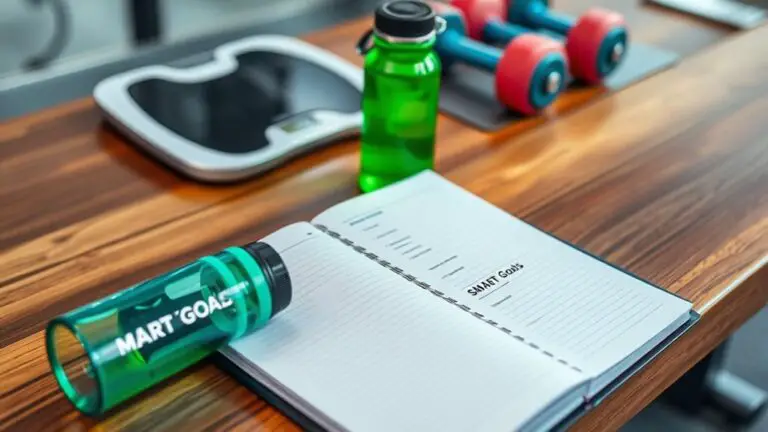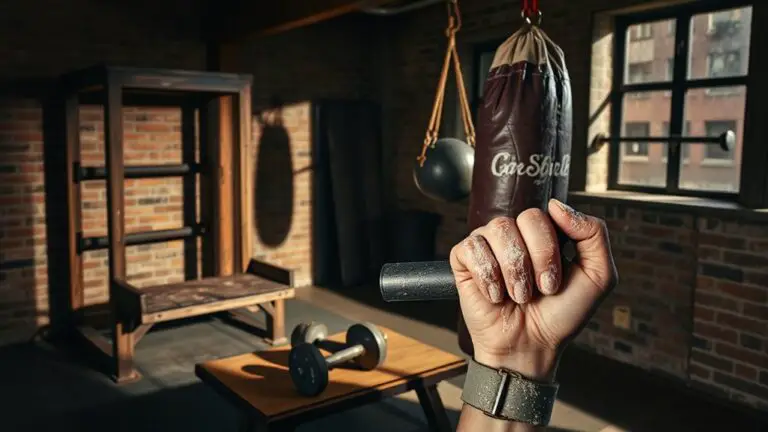How to Modify Your Gym Training for Seasonal Affective Disorder

To modify your gym training for Seasonal Affective Disorder (SAD), prioritize flexibility in your schedule. Choose workout times when you feel most energetic, and consider shorter sessions of 20-30 minutes. Incorporate outdoor activities like hiking or nature walks for fresh air and uplifting surroundings. Joining group workouts can provide support and motivation. Use light therapy to boost your mood and energy levels before workouts. By making these adjustments, you can stay active and improve your well-being during tougher months. Explore more strategies for effective fitness.
Understanding Seasonal Affective Disorder and Its Impact on Fitness

Seasonal Affective Disorder (SAD) can cast a shadow over your motivation and energy levels, making it hard to stay active during the darker months. It’s essential to develop symptom awareness because recognizing how SAD impacts your mood fluctuations can help you manage its effects on your fitness routine. You might notice that some days you feel unmotivated or even lethargic, while other days, you could feel a bit more energized. Understanding this pattern is the first step in finding ways to combat these feelings.
Consider tracking your mood alongside your activity levels to identify triggers. When you’re aware of your symptoms, you can adjust your expectations and set realistic goals. For instance, on tougher days, focus on lighter activities like stretching or walking rather than intense workouts. This approach allows you to stay active while respecting your body’s needs, ultimately supporting your mental and physical well-being during the winter months.
Adjusting Your Workout Schedule
Finding the right workout schedule can make a significant difference in how you cope with SAD symptoms. It’s important to prioritize workout flexibility during this time. Rather than sticking to a rigid routine, consider making schedule adjustments that accommodate your energy levels and mood fluctuations.
If you notice you’re feeling low in the morning, try shifting your workouts to the afternoon or evening when you might feel more energized. Shorter, more frequent sessions can also be beneficial—aim for 20-30 minutes a few times a week instead of longer sessions that may feel overwhelming.
Listen to your body and adjust as needed. Incorporate activities that you enjoy, as they’re more likely to keep you motivated. Remember, the goal is to stay active without adding extra stress. By being flexible with your schedule, you can create a workout plan that supports both your physical and mental well-being.
Incorporating Outdoor Activities

While it might be tempting to stick to indoor workouts during the colder months, incorporating outdoor activities can greatly boost your mood and energy levels. Engaging with nature not only enhances your physical fitness but also helps combat the effects of Seasonal Affective Disorder. Here are four outdoor activities you can try:
- Nature Walks: Take a leisurely stroll in a nearby park or trail. The fresh air and natural surroundings can uplift your spirits.
- Outdoor Sports: Consider playing sports like basketball, soccer, or even frisbee with friends. The social aspect adds an extra layer of enjoyment.
- Hiking: Explore local hiking trails. The combination of exercise and beautiful scenery is incredibly invigorating.
- Biking: Go for a bike ride around your neighborhood or on scenic paths. It’s a fun way to get your heart rate up while enjoying the outdoors.
Embrace these activities, and you’ll likely feel more energized and positive.
Emphasizing Group Workouts and Social Interactions
Group workouts can be a game-changer for those dealing with Seasonal Affective Disorder, as they not only provide structure but also foster a sense of community. Connecting with others in a local workout group boosts your motivation and can uplift your mood. By surrounding yourself with supportive individuals, you’ll find it easier to stick to your fitness goals and combat those winter blues.
Benefits of Group Workouts
Participating in group workouts can greatly enhance your motivation and overall well-being, especially when battling the challenges of Seasonal Affective Disorder. Being part of a team fosters a sense of belonging and encourages you to stay committed to your fitness goals. Here are some key benefits of group workouts:
- Improved Motivation: The energy of a group can inspire you to push harder.
- Team Dynamics: Working together with others creates a supportive environment, making workouts more enjoyable.
- Accountability Partners: You’re less likely to skip workouts when you know others are counting on you.
- Social Interaction: Building relationships with fellow gym-goers can lift your spirits and combat feelings of isolation.
Embrace the power of community to enhance your training experience!
Finding Local Workout Communities
Finding a local workout community can be a game-changer for anyone dealing with Seasonal Affective Disorder. Engaging in community fitness not only provides a structured environment for exercise, but it also fosters connections with others who understand your struggles. Look for local events like group classes, outdoor runs, or fitness challenges. These gatherings create opportunities to bond with like-minded individuals, making workouts more enjoyable and less isolating. Plus, the accountability that comes from a group can help keep you motivated, even on the darker days. Search social media platforms, community boards, or gyms in your area to discover these valuable resources. Remember, you’re not alone in this journey; a supportive community can make all the difference.
Social Interaction Boosts Motivation
When you team up with others for workouts, the motivation can really skyrocket, especially during the darker months. Engaging in group dynamics not only lifts your spirits but also enhances your fitness accountability. Here are some ways social interactions can boost your motivation:
- Shared Goals: Working towards common fitness objectives can strengthen your commitment.
- Positive Atmosphere: The energy from others can change your mindset, making workouts feel more enjoyable.
- Encouragement: Having workout buddies to cheer you on can reduce feelings of isolation.
- Variety in Workouts: Group settings often introduce new exercises, keeping your routine fresh and exciting.
Exploring Different Workout Types
While you might feel the weight of seasonal affective disorder (SAD) during the colder months, exploring different workout types can greatly boost your mood and energy levels. Incorporating strength training into your routine can help build resilience and confidence, while cardio workouts release those feel-good endorphins. Try yoga practices to cultivate mindfulness and ease stress, combining gentle flows with mindfulness exercises for a holistic approach. Circuit training and high-intensity workouts can energize you, promoting a sense of accomplishment. If you’re looking for fun, consider joining recreational sports or dance classes; these can provide social interaction, making workouts feel less like a chore. Experiment with various types until you find what resonates with you. Remember, it’s about finding joy in movement, and even small changes can make a big difference in managing SAD. Regular exercise reduces the risk of chronic diseases and enhances overall well-being, making it a valuable part of your routine.
Utilizing Light Therapy

If you’re feeling the weight of seasonal affective disorder, light therapy can be a powerful tool to help lift your mood. Understanding the benefits, choosing the right devices, and timing your sessions can make a significant difference in your overall well-being. Let’s explore how to integrate light therapy into your routine effectively.
Benefits of Light Therapy
Light therapy can be a game-changer for those grappling with Seasonal Affective Disorder (SAD). By increasing light exposure, you can experience significant mood enhancement. Here are some key benefits of light therapy:
- Boosts Energy Levels: Regular light exposure can help combat fatigue and lethargy.
- Improves Sleep Quality: It helps regulate your circadian rhythm, promoting better sleep patterns.
- Enhances Focus: Increased light can sharpen your concentration and productivity.
- Reduces Anxiety: Light therapy can help alleviate feelings of stress and anxiety often associated with SAD.
Incorporating light therapy into your routine may not only support your mental health but also enhance your overall well-being, making it easier to stay active and engaged during the darker months.
Best Light Therapy Devices
Finding the right light therapy device can make all the difference in managing Seasonal Affective Disorder. When you’re looking for the best devices, consider options that provide at least 10,000 lux of brightness, as this intensity offers significant light therapy benefits. Look for models with adjustable brightness settings and timers, allowing you to customize your sessions. Portable devices can be great if you want flexibility during your gym workouts or daily routines. Brands like Verilux and Carex often receive high marks for their effectiveness and design. Remember, it’s essential to choose a device that suits your lifestyle and preferences, ensuring you can maintain a consistent light therapy routine for ideal results.
Timing Your Sessions
While it might be tempting to use your light therapy device whenever you have a spare moment, timing your sessions can greatly enhance their effectiveness in managing Seasonal Affective Disorder. Here are some tips to help you integrate light therapy with your gym training:
- Morning Workouts: Use your light therapy device before your morning workouts to boost energy and mood for the day ahead.
- Evening Sessions: If you prefer evening sessions, try using light therapy as you wind down to keep your circadian rhythm in check.
- Consistency: Aim for a regular schedule; using the device at the same time each day can improve results.
- Duration: 20-30 minutes is typically recommended, so plan your workouts around this timeframe for maximum benefits.
Setting Realistic Goals and Celebrating Progress

As the days grow shorter and the winter blues set in, it’s essential to set realistic goals for your gym training that align with your mental health needs. Start by breaking down your objectives into smaller, manageable steps. Instead of aiming for a 10-pound weight loss right away, focus on committing to three workouts a week or increasing your workout duration by just five minutes. This type of goal setting is not only achievable but also helps build your confidence.
Incorporate progress tracking into your routine. Whether it’s journaling your workouts or using an app, seeing your improvements can boost your motivation. Celebrate each milestone, no matter how small—whether it’s completing a new exercise or simply feeling more energized. These celebrations reinforce positive behavior and can uplift your mood during the darker months. Remember, your mental health is a crucial part of your fitness journey, so be kind to yourself along the way.
Frequently Asked Questions
Can Diet Affect My Seasonal Affective Disorder Symptoms?
Absolutely, diet can play a significant role in your seasonal affective disorder symptoms. Making dietary changes by incorporating “mood foods” like whole grains, fatty fish, and leafy greens can help improve your mood. Foods rich in omega-3 fatty acids and vitamins can enhance brain function and reduce feelings of sadness. Staying hydrated and limiting sugar can also stabilize your energy levels. Remember, a balanced diet can support your mental health during tough seasons.
What Supplements May Help With Seasonal Affective Disorder?
Just as the sun nourishes the earth, you might consider supplements to help with seasonal affective disorder. Vitamin D is essential, especially during winter months when sunlight’s scarce, as it can uplift mood and energy levels. Omega-3 fatty acids, found in fish oil, may also support mental well-being. It’s always a good idea to consult a healthcare professional before starting any new regimen, ensuring you find the right balance for your needs.
How Do I Stay Motivated During Winter Months?
Staying motivated during winter months can be tough, but it’s possible with the right strategies. Consider setting specific goals for your winter workouts to keep you focused. Try incorporating fun activities like group classes or outdoor runs when the weather permits. Motivation techniques like tracking your progress or rewarding yourself after workouts can also help. Remember, consistency is key, and finding joy in your routine will make those colder months more manageable.
Are There Specific Exercises That Boost Mood?
When it comes to boosting your mood, think of exercises as sunshine breaking through clouds. Yoga practices, with their focus on breath and mindfulness, can lift your spirits. Pair those with cardio workouts like running or cycling, which release endorphins, giving you that feel-good high. A mix of both can create a balanced routine, helping you feel energized and more positive. Remember, finding joy in movement is key to lifting your mood!
How Can I Track My Progress Effectively?
To track your progress effectively, start by incorporating progress journaling into your routine. Write down your workout metrics, like sets, reps, and weights, after each session. This’ll help you see patterns and areas for improvement. Consider using apps or spreadsheets for a visual approach. Regularly reviewing your entries will keep you motivated and accountable. Remember, celebrating small wins along the way is just as important as reaching your ultimate fitness goals!





